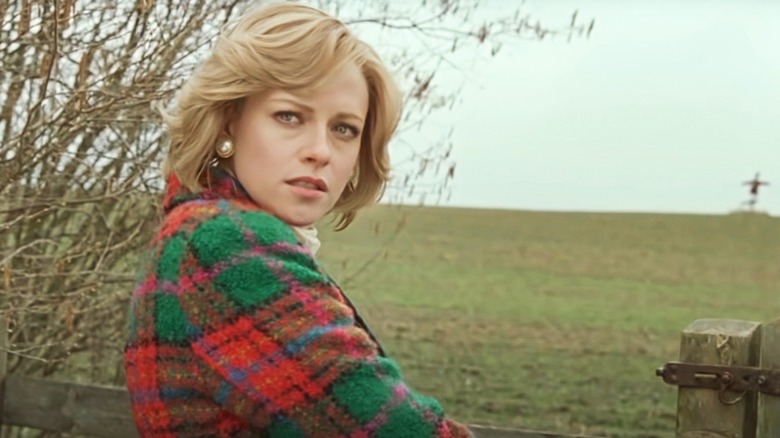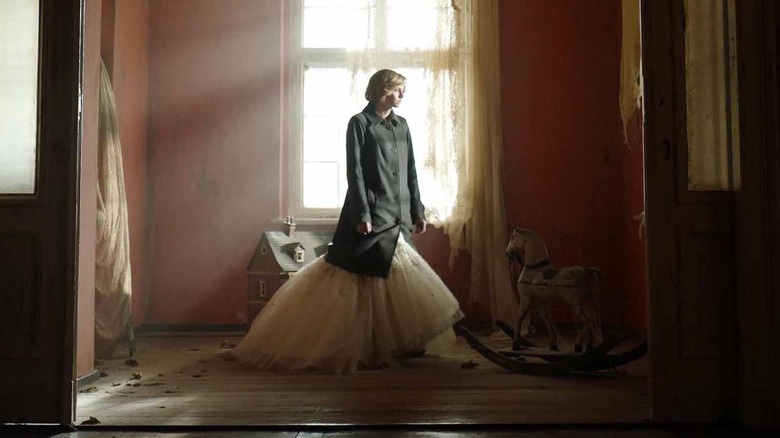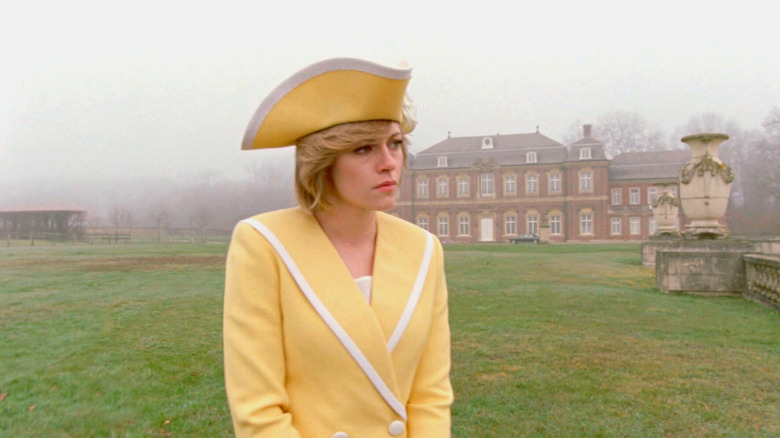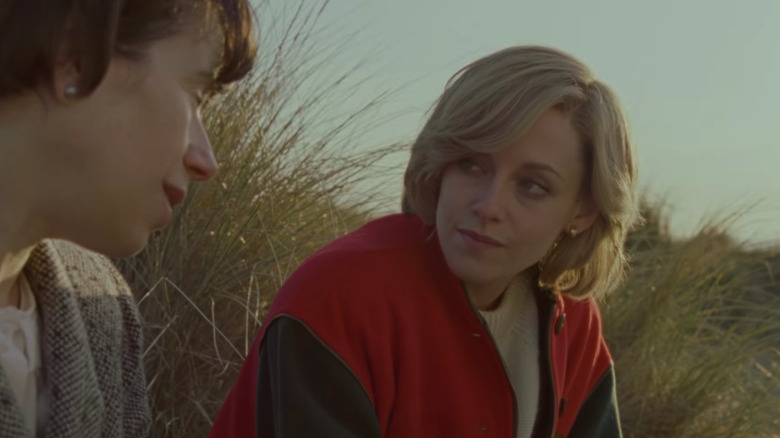Spencer Ending Explained: The Haunting Of Princess Diana
Pablo Larraín's "Spencer" quickly dispels any expectations of a conventional biopic. Before a single character can appear onscreen, the film introduces itself as "a fable from a true tragedy," then paints a portrait loosely based on life, but mostly soaked in emotion, and submerged in the perspective of Kristen Stewart's Princess Diana. Over the course of three days, the Princess of Wales is tormented by royal tradition and stifled in the ornate halls of Sandringham Estate: it's Christmas in 1991, which means another miserable holiday weekend with her stiff in-laws.
Enduring the weekend comes at great cost to her mental health, as Diana is driven to the edge of madness. All the while, dread hangs over the film, the audience just as suffocated as the protagonist. The film is confined to a mere three days, but the story and legacy of Princess Diana extend well past Boxing Day. In the grand scheme of things, we know where this story ends, the "true tragedy" of it all is seared into our brains. Yet somehow, Larraín's fable manages to carve out an insular moment of fantasy. With "Spencer" finally playing in theaters, it's time to take a closer look at the film's haunted fairy tale ending.
Spoilers for "Spencer" lie ahead.
A Ghost Story, In More Ways Than One
The ghostly nature of "Spencer" has been clear since the premise was first announced: a look into the life of the much beloved Princess Diana is inherently haunted by her death. Add Johnny Greenwood's unnerving score to the mix, with a dash of Claire Mathon's cinematography — a striking balance between misty and lush — and of course Sandringham Estate is smothered by an eerie atmosphere. Then in walks Kristen Stewart's Diana, the phantom of a woman whose legacy continues to rule over pop culture. It couldn't be any clearer if it tried: "Spencer" is a ghost story. There's even an actual ghost to prove it.
But before we meet that kindred spirit, we first meet Diana. "Spencer" zeroes in on this particular weekend as the titular character's breaking point. Emotions have bubbled to the surface and the miserable princess is well past the point of pretending. The same is true of her husband, Prince Charles (Jack Farthing), uninterested in placating her feelings or playing pretend with their marriage. Even when Diana tries fishing for affection, the Prince of Wales can't muster a single compliment for his wife, offering only piercing stares, grumpy embarrassment, and thoughtless derision.
For Christmas, he gifts his wife the same pearl necklace he bought for the woman he truly loves, Camilla Parker Bowles. But worst of all, Diana must spend much of the weekend wearing said necklace, as part of her preplanned outfits. It weighs down like a noose around her neck, a symbol of her confinement that she's encouraged to break free from. And who better to urge her towards escape than the ghostly figure of Anne Boleyn, the former Queen of England, beheaded by her husband.
For so much of the film, Diana seems utterly alone. She takes solace in her children, and occasional moments with her friend and Royal dresser, Maggie (Sally Hawkins). But for the most part, she has no one. At a dinner table full of familiar faces, Diana sees only cold judgment ... and then she sees Anne. The specter first appears because Diana finds "The Life and Death of Martyr" by Eric Ives in her bedroom, a warning we later learn was planted by Equerry Major Alistair Gregory (Timothy Spall). While he seemed to hope Diana would glimpse her potential fate and simply fall in line, she only spirals further. This is a woman beyond ready to be free, seizing any opportunity to skirt past tradition and confinement. When she looks to Anne, the warning only emphasizes how desperately she needs to escape.
After finding the book, she sees Anne in corners of the hallways and in her dreams. She walks the halls and the women merge into one — a stark reminder of how much their situations seem to have in common. If her life continues as is, she could become Boleyn, ending and all. Before finding the book, Diana speaks one of the film's most chilling lines: "Will they kill me, do you think?" Later, Anne Boleyn gives an indirect answer in the form of some crucial advice: "Run."
Escaping the Castle
Boleyn is a major inciting factor for Diana's escape, but Spall's Major Gregory also shoulders some responsibility. In addition to giving her the book in the first place, he continues to push beyond her breaking point as the weekend goes on — forcing Diana to partake in traditions, needling her with his watchful gaze, and smothering her with his perspective on her life. He tries to "reason" with her, emphasizing the importance of duty to the country. But it's surely a speech Diana has heard before. And even when speaking directly to her, he fails to see Diana as a person, only registering a particularly irritating cog in an otherwise well-oiled machine. If his companions could lay down their lives for Queen and country, why can't this woman handle getting to dinner on time?
Meanwhile, Diana must go on facing the horrors of her reality: curtains sewn shut, a stranger in her bedroom, another dress laid out for another suffocating dinner. Nearby, her family home calls out to her. Though it's abandoned and boarded up, she makes every effort to return. She's thwarted earlier in the film by the patrolling guards who report back to the major, but during Christmas dinner her determination is unstoppable. It's in her childhood home that Boleyn emerges from the darkness and encourages Diana's escape.
Spurred by Boleyn's words, "Spencer" launches into a stunning sequence: Diana walks the foggy estate, different versions of herself dancing to the crescendo of music. Stewart's Princess sways alongside the ghost of her younger self, then jumps across the tiles with her children, playing games. Though still confined within the walls of Sandringham, the sequence shows her in control, commanding her body through wordless, physical liberation as she dances. Ultimately, she runs, every iteration of her wanting to escape: a child on a bike, a school girl in uniform, and finally, the present Diana, sprinting at full pace. Then she's back in the house, ripping the pearls from her neck.
No More Fairy Tale Endings
The most carefree moments of the film see Diana finally getting some distance from the Royals. On the beach with Maggie, a love confession brings the pair laughter and joy. With the air between them wide open, they run beside the water, Diana moving freely. It gives her the strength needed to continue shattering tradition. When she interrupts the pheasant hunt, the Royals have no choice but to let her leave with her children. The boys by her side, Diana makes her grand escape: grabbing their coats and getting into the car, with "All I Need Is A Miracle" playing overhead.
No valets involved, no security and no grand destination in sight, they leave. In the distance, the scarecrow that once represented the abandoned Spencer past now wears the clothes of Diana, Princess of Wales. After getting dinner at a KFC drive thru (fast food being one of the simple, ordinary things Diana referenced earlier), she looks over the River Thames — the future is uncertain, but no longer burdened by Royal duty. Her decision has been made. This escape is final. And for a moment, we forget all grave realities and accept this ending, ominous but oddly happy.



